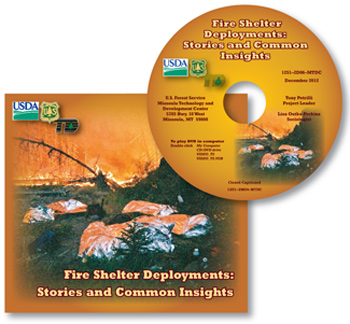
Tony Petrilli, Project Leader and Lisa Outka-Perkinds, Sociologist
The DVD "Shelter Deployments: Stories and Common Insights" is a program that will help you understand what you may experience in a fire shelter deployment and how to survive. This program does not replace the current "The New Generation Fire Shelter” training booklet (NFES 2710) or training video (NFES 2712). For a more complete training program, refer to the booklet and video. The Missoula Technology and Development Center (MTDC) based the DVD on 19 interviews with firefighters; the program has two sections.
In the first section you will hear stories from wildland firefighters, with all levels of experience from across the country, who share details about their thoughts and actions from the moment they realized they were entrapped to what they saw and felt while inside their shelters.
In the second section you will hear common insights from the shelter deployments. Firefighters share the experience and issues they faced during their deployments.
| Firefighter stories from these wildland fires | Common insights address these topics |
|
|
This collection of fire shelter deployment stories and the common insights does not advocate or glorify the use of fire shelters. Do everything you can to avoid situations where you may need to use a fire shelter. Because this is a shelter deployment program, try to put yourself in the firefighters' boots and understand how they dealt with the deployment instead of what led to the entrapment.
There is no guarantee that using a fire shelter will save your life, but what you learn in this program may help you have a better chance of survival.
Wildland Fire Shelter Deployment Reminders
Escape
- During escape, changing conditions may force you to deploy your fire shelter. Leave enough time to get on the ground and in your shelter before the heat arrives.
- Even though it may be difficult, remain focused on escape as your top priority.
Site Selection
- Practice evaluating deployment sites so you can recognize them under stressful conditions.
- Keep an eye out for potential deployment sites.
- You may have to decide whether to continue escaping or to deploy. Use your best judgement on when and where to deploy your fire shelter.
- Conditions can change very quickly. Entrapments can happen faster than you think.
- During a deployment, you may have to consider other hazards besides the fire.
Site Preparation
- Do your best to improve the site with the time and equipment (handtools, heavy equipment, and aerial resources) that you have available.
Deploying the Shelter
- It is your decision when and where to deploy the shelter.
- Try to stay focused on what is happening during the deployment and not what might happen afterwards. An investigation or review may result from an entrapment with or without the use of a shelter.
- Don't panic. Try to remain calm.
- Extreme conditions—wind, smoke, and heat make deploying the shelter more difficult.
- When time is critical, don't slow your deployment by taking non-essential items, such as a radio or water, into the shelter.
- Fire conditions are much worse outside than inside the shelter.
Inside the Shelter
- Don't panic. Try to stay calm. Expect turbulent conditions.
- Concentrate on holding down your shelter and protecting your airway.
- When it is safe to do so, you can slide your radio antenna outside the shelter to improve the signal.
- Focus on things that will help you stay calm and get through the entrapment.
- Do not leave the shelter until you are sure it is safe to do so. A drop in noise, wind, or heat are signs that it may be safe to leave the shelter.
Afterwards
- Burn injuries may be worse that they initially appear.
- Refer to the Safety chapter of the "Interagency Standards for Fire and Aviation Operations" (the Red Book) for policy on required treatment for burn injuries.
- Many firefighters return to work after experiencing a shelter deployment.
Training and PPE
- Practice shelter deployments in high stress environments that include strong winds or fans, time constraints, and different positions (standing, kneeling, and lying down).
- Practice shelter deployments while wearing all your PPE, especially gloves.
About the Authors
Tony Petrilli is an equipment specialist for the fire and aviation and safety and health programs at MTDC. He has a bachelor's degree in education from Western Montana College. Petrilli began working for the Forest Service in 1982 and joined MTDC full time in 2000. He has worked as a firefighter for the Lewis and Clark and the Beaverhead—Deerlodge National Forests and as a smokejumper for the Northern Region. He is a division/group supervisor, Type III incident commander, and has served on more than 20 fire entrapment review or investigation teams.
Lisa Outka-Perkins is a sociologist, project leader, and collateral safety officer at MTDC. She received her master's degree in sociology from the University of Montana in 2001. Her most recent DVD projects include: Monitoring Water Quality: Collecting Lake Samples, Monitoring Water Quality: Collecting Stream Samples, Calibrating Your Rangeland Drill, Firefighter Cohesion and Entrapment Avoidance, and Working Along the United States—Mexico Border.
Library Card
Petrilli, Tony; Outka-Perkins, Lisa. 2012. A New DVD About Wildland Fire Shelter Deployments. Tech Tip 1251–2319–MTDC. Missoula, MT: U.S. Department of Agriculture, Forest Service, Missoula Technology and Development Center. 4 p.
The DVD "Shelter Deployments: Stories and Common Insights" is a program that will help you understand what you may experience in a fire shelter deployment and how to survive. The Missoula Technology and Development Center (MTDC) based the DVD on 19 interviews with firefighters. The program has two sections: fire stories and common insights. The DVD serves as a companion to basic fire shelter training.
Keywords: burnovers, DVDs, fire fighting, firefighting, human factors, leadership, safety at work, training, videos, wildland fires
To order the "Shelter Deployments: Stories and Common Insights" DVD or copies of this tech tip, contact MTDC:
USDA Forest Service
Missoula Technology and Development Center
5785 Hwy. 10 West
Missoula, MT 59808–9361
Phone: 406–329–3900
Fax: 406–329–3719
Email: wo_mtdc_pubs@fs.fed.us
Electronic copies of MTDC’s publications are available on the Internet at:
http://www.fs.fed.us/eng/pubs/
For additional technical information, contact MTDC:
Phone: 406–329–3900
Fax: 406–329–3719
Missoula Technology and Development Center
Forest Service and Bureau of Land Management employees can search MTDC’s documents, CDs, DVDs, and videos on their internal computer networks at:
http://fsweb.mtdc.wo.fs.fed.us/search/
The Forest Service, United States Department of Agriculture (USDA), has developed this information for the guidance of its employees, its contractors, and its cooperating Federal and State agencies and is not responsible for the interpretation or use of this information by anyone except its own employees. The use of trade, firm, or corporation names in this document is for the information and convenience of the reader and does not constitute an endorsement by the Department of any product or service to the exclusion of others that may be suitable.
The U.S. Department of Agriculture (USDA) prohibits discrimination in all its programs and activities on the basis of race, color, national origin, age, disability, and where applicable, sex, marital status, familial status, parental status, religion, sexual orientation, genetic information, political beliefs, reprisal, or because all or part of an individual’s income is derived from any public assistance program. (Not all prohibited bases apply to all programs.) Persons with disabilities who require alternative means for communication of program information (Braille, large print, audiotape, etc.) should contact USDA’s TARGET Center at (202) 720-2600 (voice and TDD). To file a complaint of discrimination, write USDA, Director, Office of Civil Rights, 1400 Independence Avenue, S.W., Washington, D.C. 20250-9410, or call (800) 795-3272 (voice) or (202) 720-6382 (TDD). USDA is an equal opportunity provider and employer.


